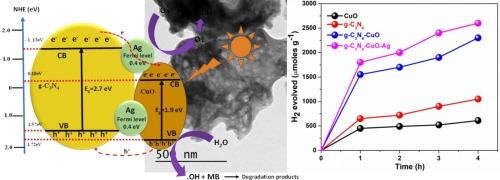多孔g-C₃N₄基CuO@Ag纳米复合材料的制备及其在可见光下光催化降解亚甲基蓝染料和析氢
IF 5.1
3区 材料科学
Q2 MATERIALS SCIENCE, COATINGS & FILMS
引用次数: 0
摘要
在这项工作中,开发了一种制备多孔石墨氮化碳(g-C₃N₄)基CuO@Ag纳米复合材料的简便策略。通过葡萄糖介导的简单热聚合反应制备了多孔二维g-C3N4片材。采用简单沉淀法在g-C3N4表面修饰CuO纳米颗粒。通过还原法制备了g-C3N4表面的银纳米颗粒。在这个过程中,葡萄糖负责银的还原和多孔材料的产生。这是利用葡萄糖合成双功能化合物的首次报道。采用XRD、FTIR、FESEM、TEM和UV-DRS等手段对合成的纳米材料的晶相、功能、形成、形貌和光学性能进行了表征。合成的复合材料在可见光下对亚甲基蓝染料的降解和析氢具有明显的光催化活性。优化后的纳米复合材料在120 min内实现了~ 98%的染料去除率,析氢速率为2700 μmol h−1 g−1,比单组分和纯g- c₃N₄要高得多。降解结果也显示出良好的循环稳定性。Ag纳米粒子的局部表面等离子体共振(LSPR)和异质结过程中有效的电子-空穴分离是其性能提高的原因。CuO纳米粒子和等离子体Ag对多孔g-C₃N₄的协同作用显著增强了可见光吸收、电荷分离和表面活性位点。本文章由计算机程序翻译,如有差异,请以英文原文为准。

Facile preparation of porous g-C₃N₄-based CuO@Ag nanocomposite for photocatalytic degradation of methylene blue dye and hydrogen evolution under visible light
In this work, a facile strategy was developed for the preparation of porous graphitic carbon nitride (g-C₃N₄) based CuO@Ag nanocomposite. A porous 2D g-C3N4 sheet was prepared via a simple glucose-mediated thermal polymerization reaction. CuO nanoparticles were decorated on the g-C3N4 surface using a simple precipitation method. Ag nanoparticles were formed on the g-C3N4 surface by the reduction method. In this process, glucose is responsible for both the reduction of Ag and the creation of porous material. This is the first report of dual-functional synthesis using glucose. The crystalline phase, functionality, formation, morphology, and optical properties of synthesized nanomaterials were determined using XRD, FTIR, FESEM, TEM, and UV-DRS. The resulting composite material exhibited remarkable photocatalytic activity for the degradation of methylene blue dye and hydrogen evolution under visible-light irradiation. The optimized nanocomposite achieved ∼98 % dye removal within 120 min and a hydrogen evolution rate of 2700 μmol h−1 g−1, which is much higher compared to single-component and pure g-C₃N₄. The degradation results also demonstrate excellent cyclic stability. The improved performance was ascribed to the localized surface plasmon resonance (LSPR) of Ag nanoparticles and effective electron–hole separation via a heterojunction process. The synergistic effect of CuO nanoparticles and plasmonic Ag on porous g-C₃N₄ significantly enhances visible light absorption, charge separation, and surface-active sites.
求助全文
通过发布文献求助,成功后即可免费获取论文全文。
去求助
来源期刊

Diamond and Related Materials
工程技术-材料科学:综合
CiteScore
6.00
自引率
14.60%
发文量
702
审稿时长
2.1 months
期刊介绍:
DRM is a leading international journal that publishes new fundamental and applied research on all forms of diamond, the integration of diamond with other advanced materials and development of technologies exploiting diamond. The synthesis, characterization and processing of single crystal diamond, polycrystalline films, nanodiamond powders and heterostructures with other advanced materials are encouraged topics for technical and review articles. In addition to diamond, the journal publishes manuscripts on the synthesis, characterization and application of other related materials including diamond-like carbons, carbon nanotubes, graphene, and boron and carbon nitrides. Articles are sought on the chemical functionalization of diamond and related materials as well as their use in electrochemistry, energy storage and conversion, chemical and biological sensing, imaging, thermal management, photonic and quantum applications, electron emission and electronic devices.
The International Conference on Diamond and Carbon Materials has evolved into the largest and most well attended forum in the field of diamond, providing a forum to showcase the latest results in the science and technology of diamond and other carbon materials such as carbon nanotubes, graphene, and diamond-like carbon. Run annually in association with Diamond and Related Materials the conference provides junior and established researchers the opportunity to exchange the latest results ranging from fundamental physical and chemical concepts to applied research focusing on the next generation carbon-based devices.
 求助内容:
求助内容: 应助结果提醒方式:
应助结果提醒方式:


